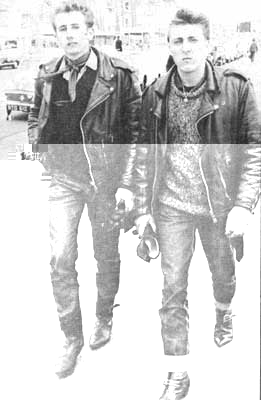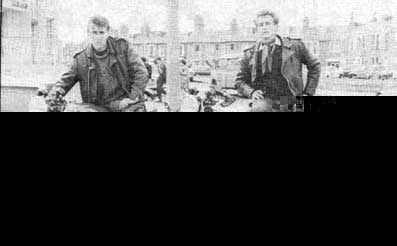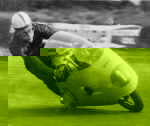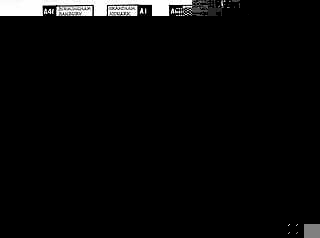A sign beside the A24 Leatherhead to Dorking road in Surrey warns
travellers: DECEPTIVE BENDS. Hemmed in by tall hedgrows and confronted
by blind curves, the average cautious human eases the accelerator to
negotiate these hazards
But to a minority of motorcylists in the
1960s, the deceptive bends signpost only acted as a spur to turn on
speed. These riders were the infamous rockers, leather-jacketed youths
on thundering British vertical twins, and their aim was to take the
curves as fast as possible-up to 100mph.
The Deceptive Bends stood as an ultimate test of ability and nerve for
South London's Rockers, and if you could take them on the limit, your
rating as a bike rider was assured. |  |
The Cheam Burners, the clique
of half a dozen rockers in which Paul Morin rode, liked to tackle the
corners in the Leatherhead to Dorking direction. This gave an initial
group of four bends separated by a long straight from two more corners.
What the group called the 'Dork Four', the last of the first batch of
bends, was crucial because the rate at which it was taken governed the
speed a bike would achive along the succeeding straight.
Speedometers of the day were useless instuments at high speed their
needles fluttered arbitrarily round the dial under the hammering meted
out by a hard ridden vertical twin- so the Chem Burners worked out
velocities according to gearing and rev counter readings. Paul, then in
his earliy twenties; calculated that at 6,000rpm his 750cc Norton Atlas
and the Norton 650SS of his friend Ted Raymond were doing 103mph.
"we used to hold the bikes at just under 6,000 - five to eight
to be exact going through Dork four, so we were reaching just about the
ton. We had lines marked on the rev counter at 6,000 and peak revs of
six-eight, and we used to glance down at the dial to see what we were
doing just before going into the corner," Paul, on the right below, says. | "Ted was the only one of us ever got
through Dork four at 6,000. We belived him when he told us this because
our group never lied about speeds, unlike some other gangs. At six-eight
in top our Nortons were doing 117mph, but we only saw that half a dozen
times. " The extrordinary antics of the rocker cult, and the inevitable
high mortality rate amoung its members, earned motorcycling lurid
headlines in the national and local press in the sixties. But in those
days young men and their girlfriends on the pillion-liberated female
riders were few then- developed an insatible lust for public road
racing, a pastime also kown as cafe racing, or burning.
Rockers
formed unoffical but recognisable groups, each identifying with a
particular cafe and often with one preferred make of motorcycle. The
Cheam Burners gathered at the Harlequin in Cheam and made 'commuting'
runs to the Tirola in Dorking , about ten miles away. Other favoured
haunts were the Caprice, Howes and Bernie's, in the Morden area, and the
Toast Rack in Sutton, and the Nightingale and Saltbox cafes in Biggin
Hill. |
Occasional forays would be made to the famous Busy
Bee in North London, and if the group was beating down to the coast for
a day, a stop would be made at the Blue Pencil at Crawley. "These places
welcomed you as a motorcyclist. There is nothing like them anymore."
Paul says. "we never gave trouble. I remember one rocker rode his bike
right into the Toast Rack when he had a row with the owner, but that was
unusal."
Paul got into 'burning' via an apprenticeship served
on a tuned Triumph Tiger Cub. In 1962 he brought his first big bike, a
year old 650cc Matchless G12 CSR , and felt he had earned respect from
other motorcylists. But he and Ted Raymond , then mounted on a BSA Gold
Flash, were given a lesson in machine handling when they were passed in
the Deceptive Bends by a smooth-riding figure on a Norton twin
"He really showed us how to do it. We caught up with him at the Tirola
and found that his name was Ken Hugget- he later became well -known road
racer who won the Manx Grand Prix. His Norton was typical rocker's bike-
nothing flash, but a bit stripped. That experience was what got us into
the rocker scene. I had a long discusson with Ted and we decided the
only way to keep up was to buy Norton's.  |
Coincendentialy, Paul was banned in 1963 for riding at dangerous speeds,
and sold the Matchless.
By the time the ban had expired the 750
Norton Atlas had been launched, and in 1964 paul bought one of the first
from dealer Paul Dunstall, who was to become famous for his Dunstall
Dominators. Armed with Norton equipment, the Cheam Burners met few
defeats on the South London roads. |
"The only time we got
thrashed was when a couple of tuned Triumphs fitted with DMD fairings
got by us," Paul says. "It was one evening when this challenge match
came up with Ginger and Gus from the Morden lot. The course started from
a lay-by and included a roundabout, the Deceptives and a straight. It
was a couple of miles long, and the first one past the lay-by again was
the winner.
'We beat them round the bends, but they got us down the
straight---my petrol taps vibrated shut and Ken's 650 SS holed a piston.
About thirty people, mainly Triumph boys, were there to see the racing
and we got a jeering. Word went round like wildfire and people would
come up to us and say, "I hear you lot got thrashed by the Morden lot."
We were very upset about it at the time."|
For those that remember,
Ginger used to hang around with another Rocker called Meggas - but
the man of the day to beat was probably " Voodoo ". Voodoo was more of a Johnson's
Cafe hang around but their Triumphs were always distinctive due to their
great full-race dustbin fairings. I wonder where he is today. |  |
Ted Raymond, leader of the Cheam Burners and the groups fastest rider
through high speed corners, rode a BSA Gold Flash in 1963, the Norton
650 SS in 64-65, a Triumph Bonneville in 65, and a Norton Atlas in
65-66. Rod "Cowboy" Symes rode a BSA Shooting Star from 1963-65, and a
Triumph T110 65-67. Pete "Wis" Thistle, owned a Norton 600 twin in
1964-66 but changed to a Norton Inter ohc single in 67. Ady "Wet
Weather" Coulman, so named because of his exceptional riding ability in
the rain, handled a 600 Norton, and a rider who was a member of the
group only briefly, Keith "The Conny Burner" rode a big Enfield.  | Bikes were rated according to their cafe
racer potential. "Respect" was the operative word; machines either
earned it or were dismissed as feeble for burning purposes. The
Bonneville was always the most respected bike, hotly pursued by the
Norton 650SS, Paul remembers.
The Bonneville was number one
because of its speed and looks. The Nortons were rated for speed and
roadholding, but they were so much more expensive than the Triumphs that
there were very few around. |
In the early days of the
rocker period, BSA's were well respected but when the unit-construction
twins came along BSA were not rated---people said they didn't look like
real bikes, although I personally considered it to be a much more
effecient design. The GoldStar and the Rocket Goldie were always
accepted, though. " The Enfield Constillation was quite respected, but
there were not many around. In the early days the Matchless G12 CSR and
the AJS 31 CSR were respected, but not in the later period---they were
too slow in comparison with the Bonnie. Vello's were well respected but
Vellocette riders were Barbour-suit boys, not rockers. They used to ride
all over the country---we thought they were mad!
'Some of the
smaller bikes were also rated. For a 250, the Ariel Golden Arrow went
well, and you also had your younger rocker groups on the 250 Royal
Enfields, the Super Five, and the Continental. " Apart from Triumph and
Nortons, reliability among bikes subjected to the stresses of burning
was "disgusting", according to Paul. He remembers BSA and Matchless as
being particulary prone to breakdowns and oil leaks. Rockers were not
fetishists for polishing or servicing carried out to strict routines,
but if a bike developed a fault, an owner would spend his last pennie to
correct it.
A leather jacket was the main item in a rocker's
wardrobe. " Jackets had to be short with lots of zips. Tassles were not
common then---Rod Symes was known as "Cowboy" because he was unusual in
having them on his jacket. Boots had to be square-shpaed at the toes,
but if you wore shoes or low-cut cowboy boots, they had to have
winkle-picker pointed toes. Helmets were not compulsory then, but we
always wore them for serious burning, pudding basins in the early stage,
"jet" type helmets later. " |
Crashes and skirmishes with the law were inevitable. Paul damaged his
650CSR, two cars and one of his kneecaps when a gap he was riding
through suddenly closed. Three mothes after he bought his Atlas he wrote
it off when he collided with a Triumph Herald car. The car was also
destroyed and Paul, who had not been wearing a hlemet, suffered a
fractured skull.
He had to rebuild the Norton in his bedroom
because he had only third-party insurance cover. |
In 1964,
Rod Symes suffered a double fracture of the skull when a car pulled out
in front of him to overtake another vehicle when he was already
committed to a passing manoeuvre. A number of years ago, long after the
rocker era had finished, he was killed in an accident while riding a
Triumph Bonneville. Ted Raymond was killed, ironically, in a car in
1966. What did rockers feel about the risks they were taking? "You never
thought about it, " Paul reflects. " We used to hear about deaths with a
certain amount of sadness, but you still went just as mad. If you got
hurt you were only concerned about how soon you could get back on the
road."
Most rockers suffered periodic riding bans, but didn't
entirely miss out on the action; it was an unwritten law that those with
licences should carry the banned as pillion passengers to all 'burner
meetings', which in the case of the Cheam Burners took place four nights
a week. Why didn't they race on the relative safety of a proper track
instead of on the public roads? | "We used
to talk about racing , but we would say, 'It's not the same---there's
nothing coming the other way'," Paul remembers. " We were in love with
speed. Our life was bikes, burning, and birds." Paul incurred his second
ban in 1965 in a typically bizarre rocker incident when he was on
holiday in a rented caravan on a site in Great Yarmouth. He stopped to
give a lift to another holidaymaker when riding back to the site one
night, but noticed the blue flashing light of a police car when he
pulled up among the caravans. |
Realising he had been
speeding, Paul panicked at the thought of collecting anbother band and
tried to shake off the police car without using his headlight and with
his passenger on the pillion seat.
In the ensuing Keystone Cops
chase a policeman hurled his torch at the fugitives, the Atlas took off
a 60mph over a gulley in the road, and paul hit 110mph down Yarmouth's
famous seafront road, the Golden Mile, which is subject to a 30mph
limit. "I wanted to burn all the way back to Cheam and escape, " he
recalls.
Eventually he fell off on a slow corner while still in
Yarmouth, the petrified passenger rolled harmlessly to the side of the
road, and the bike's tools scattered over the ground when the seat was
dislodged. Paul scrambled the tools together and was swinging on the
kickstart lever when the law screeched to a halt in a 2.6-litre Ford
Zephyr and clapped a handcuff on his throttle wrist. In court, the
police said they had chased the Norton at 90mph but it was still pulling
away. Paul was fined 50 Quid and banned for a year for riding at dangerous
speed.
Paul Morin doesn't relate these incidents to glorify or
boast about them. He appreciates that the rocker style of riding was
near suicidal, and the last thing he would urge is that youngsters
should emulate it on today's crowded roads. But there is no denying that
the rocker cult happened; in its defence, Paul points out that cafe
racers never indulged in drinking, drugs, or violence.
Many
ex-rockers look back on the era as a high point in their lives. Paul
says: "Our house used to shake when four big twins started up outside.
Sometimes I hear a bike coming down the road just like they used to, and
I think, 'Now, I wonder who that is......' " 
|